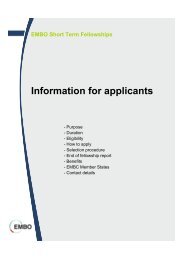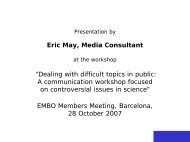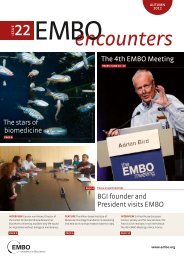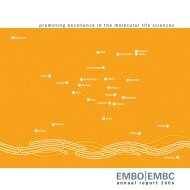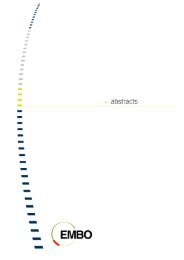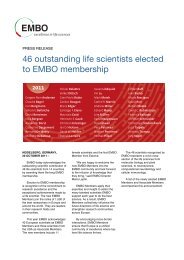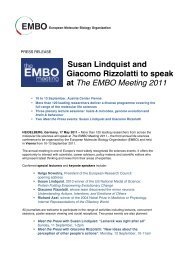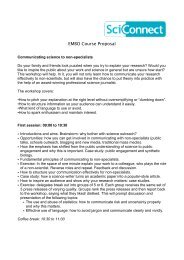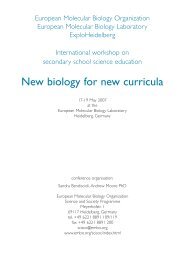Report on the Long-term Fellowship Programme based on ... - EMBO
Report on the Long-term Fellowship Programme based on ... - EMBO
Report on the Long-term Fellowship Programme based on ... - EMBO
Create successful ePaper yourself
Turn your PDF publications into a flip-book with our unique Google optimized e-Paper software.
<str<strong>on</strong>g>Report</str<strong>on</strong>g> <strong>on</strong> <strong>the</strong> L<strong>on</strong>g-<strong>term</strong> <strong>Fellowship</strong> <strong>Programme</strong><br />
<strong>based</strong> <strong>on</strong> <strong>the</strong> applicati<strong>on</strong> years 1993 and 1998<br />
Laura Cortesi, Anna Ledin and Jan Taplick<br />
For fur<strong>the</strong>r details or questi<strong>on</strong>s regarding this report please c<strong>on</strong>tact:<br />
Jan Taplick, PhD<br />
<strong>Fellowship</strong> <strong>Programme</strong> Manager, <strong>EMBO</strong><br />
European Molecular Biology Organizati<strong>on</strong><br />
Postfach 1022.40 D-69012 Heidelberg<br />
Meyerhofstrasse 1, D-69117 Heidelberg<br />
Germany<br />
Tel.: +49 6221 8891 122<br />
Fax: +49 6221 8891 215<br />
e-mail: jan.taplick@embo.org<br />
http://www.embo.org
1. General outline and programme goals<br />
The <strong>EMBO</strong> L<strong>on</strong>g-<strong>term</strong> <strong>Fellowship</strong> scheme was established to support advanced<br />
training, research and internati<strong>on</strong>al mobility of postdoctoral scientists in Europe<br />
and when justified, also in n<strong>on</strong>-European countries. Shortly after <strong>EMBO</strong> was<br />
established in 1964, <strong>the</strong> organisati<strong>on</strong> awarded <strong>the</strong> first l<strong>on</strong>g-<strong>term</strong> fellowships with<br />
funds provided by <strong>the</strong> Volkswagen Foundati<strong>on</strong>. In 1969, governments of 14<br />
countries established <strong>the</strong> European Molecular Biology C<strong>on</strong>ference (EMBC), an<br />
intergovernmental organisati<strong>on</strong> that c<strong>on</strong>tinued <strong>the</strong> funding initiated by <strong>the</strong><br />
Volkswagen Foundati<strong>on</strong> until today. Over <strong>the</strong> period of 40 years, <strong>the</strong> <strong>EMBO</strong><br />
L<strong>on</strong>g-<strong>term</strong> <strong>Fellowship</strong> scheme retained its reputati<strong>on</strong> as <strong>on</strong>e of <strong>the</strong> most<br />
prestigious programmes for research training of young scientists in <strong>the</strong> molecular<br />
life sciences. Over <strong>the</strong> years, not <strong>on</strong>ly has <strong>the</strong> number of member states of <strong>the</strong><br />
EMBC expanded to 25 countries as of today, he demand for <strong>EMBO</strong> L<strong>on</strong>g-<strong>term</strong><br />
<strong>Fellowship</strong>s has also increased from around 250 applicati<strong>on</strong>s in <strong>the</strong> 1970’s to<br />
more than 1200 proposals submitted in 2005 (Figure 1). This dem<strong>on</strong>strates <strong>the</strong><br />
popularity of <strong>the</strong> programme, but also <strong>the</strong> fact that today more students are<br />
attracted by a career in <strong>the</strong> field of modern biology.<br />
Figure 1: Applicati<strong>on</strong>s and awards 1977-2005<br />
The aim of this report is to provide <strong>the</strong> Member States of <strong>the</strong> EMBC with<br />
informati<strong>on</strong> about <strong>the</strong> achievements of <strong>the</strong> programme. Predominantly this will be<br />
<strong>based</strong> <strong>on</strong> data of L<strong>on</strong>g-<strong>term</strong> Fellows elected in 1993 and 1998. These data include<br />
achievements of <strong>the</strong> fellows during <strong>the</strong>ir <strong>term</strong>, <strong>the</strong>ir fur<strong>the</strong>r career path as well as<br />
opini<strong>on</strong>s about <strong>the</strong> fellows and <strong>the</strong> programme itself by <strong>the</strong> former supervisors. In<br />
case of <strong>the</strong> fellowship selecti<strong>on</strong>s in 1998, <strong>the</strong> <strong>EMBO</strong> office had access to all<br />
applicati<strong>on</strong> files, which made it possible to compare <strong>the</strong> fur<strong>the</strong>r careers of <strong>the</strong><br />
<strong>EMBO</strong> Fellows with those applicants who were unfortunately not selected. From<br />
<strong>the</strong> informati<strong>on</strong> <strong>on</strong> <strong>the</strong> two selected cohorts of fellows, some general c<strong>on</strong>clusi<strong>on</strong>s<br />
can be obtained.
2. The selecti<strong>on</strong> of <strong>EMBO</strong> Fellows<br />
Today more than 1200 applicati<strong>on</strong>s for <strong>EMBO</strong> L<strong>on</strong>g-<strong>term</strong> <strong>Fellowship</strong>s are<br />
received at two deadlines <strong>on</strong> February 15 and August 15 each year. The timeframe<br />
for <strong>the</strong> handling and <strong>the</strong> evaluati<strong>on</strong> of <strong>the</strong> proposals is currently 15 weeks. During<br />
this period, <strong>the</strong> fellowship programme office composed of <strong>on</strong>e <strong>Programme</strong><br />
Manager (currently Jan Taplick) and <strong>on</strong>e Administrative Assistant (currently<br />
Liselott Maidment) ensure <strong>the</strong> completeness of applicati<strong>on</strong> documents, select<br />
experts in <strong>the</strong> area of proposed research, organise <strong>the</strong> interview process and<br />
provide <strong>the</strong> <strong>Fellowship</strong> Committee a maximal possible time for <strong>the</strong> evaluati<strong>on</strong> of<br />
<strong>the</strong> applicati<strong>on</strong>s. Until 2004, all eligible applicants were invited for an expert<br />
interview with an <strong>EMBO</strong> Member or <strong>EMBO</strong> Young Investigator. Given <strong>the</strong><br />
significant increase in applicati<strong>on</strong>s since 2001, <strong>the</strong> <strong>Fellowship</strong> Committee<br />
introduced a pre-screening of applicati<strong>on</strong>s in order to identify <strong>the</strong> top 50% of<br />
applicants who are interviewed and evaluated fur<strong>the</strong>r. Since 2006, all applicati<strong>on</strong>s<br />
are received electr<strong>on</strong>ically allowing a faster processing of <strong>the</strong> applicati<strong>on</strong> files and<br />
<strong>the</strong>reby providing more time for <strong>the</strong> <strong>Fellowship</strong> Committee for <strong>the</strong> evaluati<strong>on</strong> of<br />
candidates.<br />
The selecti<strong>on</strong> of <strong>EMBO</strong> Fellows would be impossible without <strong>the</strong> dedicated work<br />
of <strong>the</strong> <strong>Fellowship</strong> Committee members who commit <strong>the</strong>ir valuable time for<br />
several years in order to ensure a fast and fair applicati<strong>on</strong> procedure and without<br />
<strong>the</strong> input of <strong>EMBO</strong> members who are involved in <strong>the</strong> expert assessment by<br />
candidate interviews. More than 600 interview reports are currently received<br />
annually. The report also aims to acknowledge <strong>the</strong>ir support of <strong>the</strong> fellowship<br />
programme during <strong>the</strong> past years.<br />
In summary, <strong>the</strong> report will dem<strong>on</strong>strate that <strong>the</strong> <strong>EMBO</strong> <strong>Fellowship</strong> Committee<br />
selected <strong>the</strong> best candidates who c<strong>on</strong>tinue to c<strong>on</strong>tribute to excellence in <strong>the</strong><br />
Molecular Life Sciences in Europe. In additi<strong>on</strong>, <strong>the</strong> report shows how <strong>the</strong> EMBC<br />
funded L<strong>on</strong>g-<strong>term</strong> <strong>Fellowship</strong>s c<strong>on</strong>tributed to <strong>the</strong> training of a new generati<strong>on</strong> of<br />
European life scientists who will have <strong>the</strong>ir stake in shaping <strong>the</strong> European<br />
research area in coming years.<br />
Members of <strong>the</strong> <strong>EMBO</strong> <strong>Fellowship</strong> Committee since 1993:<br />
Kari Alitalo (Finland)<br />
Robin Allshire (United Kingdom)<br />
Jesus Avila (Spain)<br />
Francisco Baralle (Italy)<br />
Peter Becker (Germany)<br />
Francesco Blasi (Italy)<br />
August Boeck (Germany)<br />
Bernd Bukau (Germany)<br />
Harald v<strong>on</strong> Boehmer (Switzerland)<br />
Gianni Cesareni (Italy)<br />
Francois Cuzin (France)<br />
John Diffley (United Kingdom)<br />
Bauke Dijksra (Ne<strong>the</strong>rlands)<br />
Thomas Edlund (Sweden)<br />
Costa Georgopoulos (Switzerland)<br />
Alain Ghysen (France)<br />
Nicolas Glaichenhaus (France)<br />
Crisanto Gutierrez (Spain)
Ernst Hafen (Switzerland)<br />
Reinhold Herrmannn (Germany)<br />
Cornelis Hilbers (Ne<strong>the</strong>rlands)<br />
Thomas Hohn (Switzerland)<br />
Tim Hunt (United Kingdom)<br />
Claude Jacq (France)<br />
Leszek Kaczmarek (Poland)<br />
Regine Kahmann (Germany)<br />
Robert Kaptein (Ne<strong>the</strong>rlands)<br />
Rolf Kemler, (Germany)<br />
Juergen Knoblich (Austria)<br />
Angela Kraemer (Switzerland)<br />
Wilhelm Krek (Switzerland)<br />
Robb Krumlauf (United Kingdom)<br />
Bernard Malissen (France)<br />
3. Analysis of data<br />
Diane Mathis (France)<br />
M<strong>on</strong>tserrat Pages (Spain)<br />
Anth<strong>on</strong>y Pugsley (France)<br />
Daniela Rhodes (United Kingdom)<br />
Varda Rotter (Israel)<br />
Francesco Salamini (Italy)<br />
Angela Sant<strong>on</strong>i (Italy)<br />
David Sherratt (United Kingdom)<br />
Yosef Shiloh (Israel)<br />
Herm<strong>on</strong>a Soreq (Israel)<br />
Irma Thesleff (Finland)<br />
Antti Vaheri (Finland)<br />
As indicated in <strong>the</strong> introducti<strong>on</strong>, this report is built around an indepth analysis of<br />
<strong>the</strong> statistics from 1993 and 1998 as indicators of <strong>the</strong> impact of <strong>the</strong> programme.<br />
The applicati<strong>on</strong> year 1993<br />
In 1993, <strong>the</strong> <strong>EMBO</strong> office received 739 applicati<strong>on</strong>s during <strong>the</strong> two applicati<strong>on</strong><br />
deadlines and <strong>the</strong> <strong>EMBO</strong> Fund Committee (renamed to <strong>Fellowship</strong> Committee in<br />
1996) awarded 199 fellowships corresp<strong>on</strong>ding to an excepti<strong>on</strong>ally high success<br />
rate of 27%.<br />
The following <strong>EMBO</strong> Members served in <strong>the</strong> Fund Committee in 1993:<br />
Francisco Baralle (Italy)<br />
Harald v<strong>on</strong> Boehmer (Switzerland)<br />
Francois Cuzin (France) (chair)<br />
Alain Ghysen (France)<br />
Tim Hunt (United Kingdom)<br />
Claude Jacq (France)<br />
Regine Kahmann (Germany)<br />
Robert Kaptein (Ne<strong>the</strong>rlands)<br />
Rolf Kemler, (Germany)<br />
Francesco Salamini (Italy)<br />
<strong>Fellowship</strong> applicati<strong>on</strong>s were handled by John Tooze and Jennifer Norman at <strong>the</strong><br />
<strong>EMBO</strong> Secretariat in Heidelberg. During <strong>the</strong> meeting <strong>the</strong> committee also<br />
discussed <strong>the</strong> representati<strong>on</strong> of women am<strong>on</strong>gst <strong>the</strong> applicants for <strong>EMBO</strong> L<strong>on</strong>g<strong>term</strong><br />
fellowships. This is particularly interesting when <strong>the</strong> percentage of female<br />
applicants is compared to <strong>the</strong> gender distributi<strong>on</strong> at present. Over <strong>the</strong> years <strong>the</strong><br />
percentage of women applying to <strong>the</strong> programme increased to reaching 51% in<br />
2005. This is encouraging when compared to <strong>the</strong> significant lower representati<strong>on</strong><br />
in <strong>the</strong> beginning of <strong>the</strong> 90’s when <strong>the</strong> percentage of female applicants was 26-28<br />
%.
The applicati<strong>on</strong> year 1998<br />
At <strong>the</strong> deadlines of 1998, <strong>the</strong> <strong>EMBO</strong> office received 790 applicati<strong>on</strong>s for L<strong>on</strong>g<strong>term</strong><br />
<strong>Fellowship</strong>s. The <strong>Fellowship</strong> committee awarded 144 fellowships<br />
corresp<strong>on</strong>ding to an overall success rate of 18% in 1998.<br />
The <strong>EMBO</strong> <strong>Fellowship</strong> Committee was composed of <strong>the</strong> following <strong>EMBO</strong><br />
Members:<br />
Jesus Avila (Spain)<br />
Gianni Cesareni (Italy)<br />
Reinhold Herrmannn (Germany)<br />
Cornelis Hilbers (Ne<strong>the</strong>rlands)<br />
Thomas Hohn (Switzerland)<br />
Robb Krumlauf (United Kingdom)<br />
Diane Mathis (France) (chair)<br />
David Sherratt (United Kingdom)<br />
Herm<strong>on</strong>a Soreq (Israel)<br />
Antti Vaheri (Finland)<br />
The applicati<strong>on</strong>s were processed in <strong>the</strong> <strong>EMBO</strong> office by Frank Gann<strong>on</strong> and<br />
Jennifer Norman.<br />
Figure 2 shows <strong>the</strong> impact factors of first author publicati<strong>on</strong>s by candidates of <strong>the</strong><br />
applicati<strong>on</strong> year 1998 and <strong>the</strong> scores given by <strong>the</strong> committee members.<br />
Figure 2: Impact factors and committee scores 1998<br />
When judging applicati<strong>on</strong>s, <strong>the</strong> <strong>Fellowship</strong> Committee has to take several factors<br />
into account when deciding <strong>on</strong> <strong>the</strong> awards of l<strong>on</strong>g-<strong>term</strong> fellowships. Those<br />
include <strong>the</strong> past achievements of candidates, <strong>the</strong> biological significance of <strong>the</strong><br />
research proposal and <strong>the</strong> quality of <strong>the</strong> receiving laboratory. This figure suggests<br />
that <strong>the</strong> cumulative impact factors of journals in which candidates published <strong>the</strong>ir<br />
first author articles until 1998 was not <strong>the</strong> <strong>on</strong>ly criteri<strong>on</strong> for <strong>the</strong> committee when
coming to decisi<strong>on</strong>s since no significant differences between many awarded and<br />
rejected candidates can be observed. It is <strong>the</strong>refore important to recall that o<strong>the</strong>r<br />
aspects such as proposed research project, quality of <strong>the</strong> host laboratory, career<br />
stage of applicants and performance during <strong>the</strong> interview all c<strong>on</strong>tribute to <strong>the</strong> final<br />
score given by <strong>the</strong> fellowship committee members. A linear correlati<strong>on</strong> between<br />
<strong>the</strong> committee score and <strong>the</strong> publicati<strong>on</strong> record is <strong>the</strong>refore not to be expected.<br />
The same comparis<strong>on</strong> was d<strong>on</strong>e for all first and last author articles of awarded and<br />
rejected candidates by following <strong>the</strong>ir careers from 1998 until 2006. Such a<br />
comparis<strong>on</strong> is a partial indicator for <strong>the</strong> research output of <strong>the</strong> two groups after <strong>the</strong><br />
decisi<strong>on</strong> of <strong>the</strong> fellowship committee in 1998. As dem<strong>on</strong>strated in Figure 3, most<br />
of <strong>the</strong> selected <strong>EMBO</strong> Fellows achieved a cumulative impact factor of higher than<br />
20, which is not <strong>the</strong> case for many applicants who were rejected in 1998.<br />
Figure 3: Impact factors until 2006 and committee scores in 1998<br />
However, this comparis<strong>on</strong> also shows that <strong>the</strong> performance of many rejected<br />
applicants resulted in high impact factor publicati<strong>on</strong>s. This implies that <strong>the</strong> EMBC<br />
and <strong>EMBO</strong> would be able to support more excellent candidates if more funds<br />
would be available for <strong>the</strong> fellowship programme.<br />
The Fellows and Supervisors Questi<strong>on</strong>naires<br />
In order to assess <strong>the</strong> achievements of <strong>the</strong> L<strong>on</strong>g-<strong>term</strong> Fellows during <strong>the</strong>ir<br />
EMBC/<strong>EMBO</strong> supported <strong>term</strong> and <strong>the</strong>ir later career path, a questi<strong>on</strong>naire was<br />
send to <strong>the</strong> respective groups of <strong>EMBO</strong> fellows selected in 1993 and 1998 as well<br />
as to applicants rejected in 1998.<br />
As suggested by <strong>the</strong> C<strong>on</strong>ference during <strong>the</strong> presentati<strong>on</strong> of <strong>the</strong> Quality <str<strong>on</strong>g>Report</str<strong>on</strong>g> <strong>on</strong><br />
Short-<strong>term</strong> <strong>Fellowship</strong>s in 2003, <strong>the</strong> supervisors of <strong>the</strong> <strong>EMBO</strong> fellows also were
c<strong>on</strong>tacted and asked for <strong>the</strong>ir opini<strong>on</strong>s <strong>on</strong> <strong>the</strong> performance of <strong>the</strong> <strong>EMBO</strong> Fellows<br />
and about <strong>the</strong> <strong>EMBO</strong> L<strong>on</strong>g-<strong>term</strong> <strong>Fellowship</strong>s in general.<br />
A detailed list of <strong>the</strong> questi<strong>on</strong>s answered by fellows, applicants and supervisors is<br />
listed in <strong>the</strong> Annex.<br />
General resp<strong>on</strong>ses to <strong>the</strong> questi<strong>on</strong>naires<br />
In order to find out current locati<strong>on</strong>s and addresses of fellows, supervisors and<br />
applicants several searches had to be performed. Those included PubMed searches<br />
for recent publicati<strong>on</strong>s, internet search engines and pers<strong>on</strong>al c<strong>on</strong>tacts of former<br />
supervisors.<br />
As shown in Table 1, around 80% of former <strong>EMBO</strong> Fellows and more than 90%<br />
of supervisors were located. However, <strong>on</strong>ly 62% of current addresses of<br />
applicants who were rejected in 1998 could be located.<br />
total N located % located Replied % replied % of N<br />
1993 Awards 190 152 80 107 70 56<br />
1993 Supervisors 190 177 93 128 72 67<br />
1998 Awards 130 103 79 81 79 62<br />
1998 Supervisors 130 119 92 80 67 62<br />
1998 Applicants 584 364 62 193 53 33<br />
Rejected 542 335 62 181 54 33<br />
Withdrawn 42 29 69 12 41 29<br />
TOTAL 1224 915 75 589 64 48<br />
Table 1: Statistics <strong>on</strong> received replies from fellows, applicants and supervisors<br />
Around 70% (67-79%) of <strong>EMBO</strong> Fellows and <strong>the</strong>ir former supervisors resp<strong>on</strong>ded<br />
and completed <strong>the</strong> questi<strong>on</strong>naire. Despite several reminders, <strong>the</strong> resp<strong>on</strong>se rate by<br />
applicants rejected in 1998 is significantly lower at 53%, which has to be taken<br />
into account during <strong>the</strong> comparis<strong>on</strong> of applicants and fellows later in <strong>the</strong> report.<br />
Experience as an <strong>EMBO</strong> Fellow<br />
The aim of <strong>the</strong> <strong>EMBO</strong> L<strong>on</strong>g-<strong>term</strong> fellowship scheme is to identify <strong>the</strong> most<br />
promising young scientists and to support <strong>the</strong>ir postdoctoral training in excellent<br />
laboratories abroad in order to prepare for <strong>the</strong>ir future careers as independent<br />
scientists in <strong>the</strong> molecular life sciences.<br />
When asked about <strong>the</strong> opportunities provided by <strong>the</strong> <strong>EMBO</strong>/EMBC supported<br />
postdoctoral training, <strong>the</strong> majority of <strong>EMBO</strong> Fellows indicated that it allowed
<strong>the</strong>m to obtain <strong>the</strong>ir training in a leading internati<strong>on</strong>al laboratory. The fellows also<br />
stated that <strong>the</strong> fellowship allowed <strong>the</strong>m to work independently in <strong>the</strong> host<br />
laboratory, provided <strong>the</strong>m with <strong>the</strong> opportunity to work abroad for part of <strong>the</strong>ir<br />
career and to change <strong>the</strong> research area after <strong>the</strong>ir graduate training. Table 2<br />
summarizes <strong>the</strong> answers of <strong>the</strong> <strong>EMBO</strong> Fellows selected in 1993 and 1998<br />
regarding <strong>the</strong> opportunities provided by <strong>the</strong> <strong>EMBO</strong> L<strong>on</strong>g-<strong>term</strong> <strong>Fellowship</strong>:<br />
1993 % 1993 1998 % 1998<br />
Work in a leading laboratory 87 32.6 62 30.1<br />
Work independently in <strong>the</strong> host<br />
laboratory 52 19.5 51 24.8<br />
Start internati<strong>on</strong>al collaborati<strong>on</strong>s 24 9.0 22 10.7<br />
Change country 53 19.9 34 16.5<br />
Change research area 42 15.7 32 15.5<br />
O<strong>the</strong>rs 9 3.4 5 2.4<br />
Table 2: Appreciati<strong>on</strong> of opportunities offered by <strong>the</strong> <strong>EMBO</strong> <strong>Fellowship</strong> (multiple<br />
opti<strong>on</strong>s could be selected)<br />
As indicated by <strong>the</strong> cumulative impact factor analysis and <strong>the</strong> literature searches<br />
to find <strong>the</strong>ir current locati<strong>on</strong>, <strong>the</strong> majority of former <strong>EMBO</strong> Fellows are pursuing<br />
a successful career in science. Therefore, <strong>the</strong>ir opini<strong>on</strong> <strong>on</strong> how <strong>the</strong> <strong>EMBO</strong>/EMBC<br />
supported postdoctoral stay abroad influenced <strong>the</strong>ir career is particularly<br />
interesting for judging <strong>the</strong> achievements of <strong>the</strong> programme (see Table 3). In both<br />
groups of fellows, most stated that <strong>the</strong>ir postdoctoral training in an excellent<br />
foreign laboratory resulted in a str<strong>on</strong>ger publicati<strong>on</strong> record that allowed <strong>the</strong>m later<br />
to compete successfully for <strong>the</strong>ir next positi<strong>on</strong>. A relatively high percentage of<br />
fellows also indicated that <strong>the</strong>ir move to ano<strong>the</strong>r country broadened <strong>the</strong>ir horiz<strong>on</strong>s<br />
by learning about a different culture and living envir<strong>on</strong>ment. Fur<strong>the</strong>rmore, <strong>the</strong>ir<br />
fur<strong>the</strong>r career was influenced by <strong>the</strong> fact that many established collaborati<strong>on</strong>s<br />
during <strong>the</strong>ir training that last until today and that <strong>the</strong>y were able to become part of<br />
an internati<strong>on</strong>al research network.<br />
1993 % 1993 1998 % 1998<br />
Str<strong>on</strong>ger publicati<strong>on</strong> list 74 31.0 52 30.4<br />
Job offer 42 17.6 28 16.4<br />
Learned & appreciated a different<br />
culture 44 18.4 37 21.6<br />
Established collaborati<strong>on</strong>s that<br />
lasted 42 17.6 24 14.0<br />
Networking 30 12.6 21 12.3<br />
O<strong>the</strong>rs 7 2.9 9 5.3<br />
Table 3: Influence <strong>on</strong> fur<strong>the</strong>r career (multiple opti<strong>on</strong>s could be selected)
The vast majority of fellows were satisfied with <strong>the</strong> host laboratory <strong>the</strong>y had<br />
selected for <strong>the</strong>ir postdoctoral training (1993: 96% / 1998: 88%). These figures<br />
will also be reflected by <strong>the</strong> opini<strong>on</strong>s of supervisors later in <strong>the</strong> report.<br />
The <strong>on</strong>going collaborati<strong>on</strong> with <strong>the</strong> former host laboratory is naturally higher for<br />
those fellows selected in 1998 with 50.6% having still collaborative projects with<br />
<strong>the</strong>ir former supervisors (see Table 4). The percentage of 1993 <strong>EMBO</strong> Fellows<br />
having still <strong>on</strong>going collaborati<strong>on</strong>s with <strong>the</strong> former host laboratory is significantly<br />
lower with 34% indicating that many of <strong>the</strong>m established <strong>the</strong>ir own research line<br />
in <strong>the</strong> meantime or have evolved in <strong>the</strong>ir pool of collaborati<strong>on</strong>s.<br />
1993 % 1993 1998 % 1998<br />
Yes 34 32.4 41 50.6<br />
No 71 67.6 40 49.4<br />
Table 4: Ongoing collaborati<strong>on</strong> with <strong>the</strong> former host laboratory<br />
The <strong>EMBO</strong>/EMBC supported period in <strong>the</strong> host laboratory resulted in an average<br />
of 3 publicati<strong>on</strong>s for both groups selected in 1993 and 1998. The total number of<br />
publicati<strong>on</strong>s achieved during <strong>the</strong> postdoctoral training in host laboratory was<br />
higher with an average of 6 publicati<strong>on</strong>s for those selected in 1993 and 4 articles<br />
for fellows of 1998. This difference can be explained by <strong>the</strong> fact that fellows<br />
stayed for a l<strong>on</strong>ger period in <strong>the</strong> host laboratory supported by alternative sources.<br />
Career path of <strong>EMBO</strong> Fellows<br />
One impressive and encouraging result is that <strong>the</strong> vast majority of former fellows<br />
followed a successful career in science after <strong>the</strong>ir <strong>EMBO</strong>/EMBC supported<br />
postdoctoral training. Figure 4 dem<strong>on</strong>strates that almost every fellow is active in<br />
research after <strong>the</strong>y finished <strong>the</strong>ir postdoctoral <strong>term</strong> five or ten years ago.<br />
Figure 4: Current career status
Figure 4 also shows that <strong>the</strong>re is almost no difference between <strong>EMBO</strong> Fellows<br />
selected in 1998 and those applicants who were not accepted in <strong>the</strong> programme.<br />
However, as pointed out earlier in <strong>the</strong> report, <strong>the</strong> resp<strong>on</strong>se rate of applicants was<br />
significantly lower and it was not possible to obtain a valid address for 38% of<br />
rejected applicants. This might suggest that <strong>the</strong> percentage of applicants who left a<br />
scientific career might be higher than <strong>the</strong> data shown in Figure 4 is suggesting,<br />
particularly as <strong>the</strong> search tools used to locate applicants would have a low chance<br />
to find individuals that are not publishing.<br />
In order to obtain informati<strong>on</strong> about <strong>the</strong> current scientific activity of all fellows<br />
and applicants who were evaluated in 1998 and not <strong>on</strong>ly from those who<br />
resp<strong>on</strong>ded to <strong>the</strong> questi<strong>on</strong>naire, an in-depth search for publicati<strong>on</strong>s was<br />
performed. The aim of this search was to de<strong>term</strong>ine in which year <strong>the</strong> last<br />
publicati<strong>on</strong>s of fellows and rejected candidates were published in <strong>the</strong> scientific<br />
literature. This would indicate <strong>the</strong> date of <strong>the</strong>ir “drop-out” from academic research<br />
but cannot be equated with <strong>the</strong> end of <strong>the</strong>ir careers as many jobs open to fellows<br />
would not result in publicati<strong>on</strong>s in <strong>the</strong> scientific literature. As shown in Figure 5,<br />
<strong>the</strong> percentage of rejected applicants who published in 2005 and 2006 is<br />
significantly lower compared to <strong>EMBO</strong> fellows. The opposite result is obtained<br />
for <strong>the</strong> years 1998 to 2004 when <strong>the</strong> percentage of applicants publishing <strong>the</strong>ir last<br />
article was always higher compared to <strong>EMBO</strong> Fellows. This is indeed indicating<br />
that more applicants who were rejected in 1998 left a career in academic science<br />
compared to <strong>the</strong> data presented in Figure 4 where no difference between fellows<br />
and applicants was observed.<br />
Figure 5: Last year of publicati<strong>on</strong> of awarded and rejected applicants<br />
The majority of scientists who replied are currently working in academia. Around<br />
90% of former fellows are currently pursuing a career in academic research<br />
instituti<strong>on</strong>s. A slightly higher proporti<strong>on</strong> of <strong>the</strong> rejected applicants moved to
industry as compared to former <strong>EMBO</strong> Fellows (Figure 6). When asked for <strong>the</strong><br />
reas<strong>on</strong>s for leaving an academic envir<strong>on</strong>ment, unclear career perspectives and<br />
unsatisfactory salary levels were menti<strong>on</strong>ed as <strong>the</strong> main reas<strong>on</strong> for <strong>the</strong> decisi<strong>on</strong> to<br />
move to industry.<br />
Figure 6: Current place of work<br />
A crucial in every scientific career is <strong>the</strong> ability to secure a positi<strong>on</strong> as an<br />
independent researcher following <strong>the</strong> postdoctoral training period and to c<strong>on</strong>tinue<br />
<strong>the</strong> career path as group leader, associate or full professor. Figures 7 A-C<br />
summarize <strong>the</strong> current career stages of <strong>the</strong> different groups in this survey.<br />
Figure 7A: Current positi<strong>on</strong>s of 1993 <strong>EMBO</strong> Fellows
Figure 7B: Current positi<strong>on</strong>s of 1998 <strong>EMBO</strong> Fellows<br />
Figure 7C: Current positi<strong>on</strong>s of rejected applicants of 1998<br />
One encouraging result is that <strong>the</strong> majority of 90% of 1993 <strong>EMBO</strong> Fellows are in<br />
permanent research positi<strong>on</strong>s with 13% being Full Professors, 31% Associate<br />
Professors, 39% group leaders and 7% occupying positi<strong>on</strong>s as permanent<br />
researchers or staff scientists. <strong>EMBO</strong> Fellows selected in 1998 were also very
successful in applying for permanent research positi<strong>on</strong>s since <strong>on</strong>ly 5% of <strong>the</strong>m are<br />
still postdoctoral scientists five years after <strong>the</strong>y completed <strong>the</strong>ir <strong>term</strong> as <strong>EMBO</strong><br />
Fellows. The percentage of rejected applicants still holding postdoctoral is higher<br />
at 16%. However, two rejected applicants succeeded in obtaining a positi<strong>on</strong> as<br />
Full Professor. A direct comparis<strong>on</strong> of <strong>the</strong> positi<strong>on</strong>s occupied by <strong>the</strong> three groups<br />
is provided in Figure 8.<br />
Figure 8: Comparis<strong>on</strong> of current positi<strong>on</strong>s<br />
Research in <strong>the</strong> life sciences became increasingly internati<strong>on</strong>al over <strong>the</strong> last<br />
decades including a higher mobility between nati<strong>on</strong>s. This internati<strong>on</strong>alisati<strong>on</strong> is<br />
an important c<strong>on</strong>tributor to <strong>the</strong> promoti<strong>on</strong> of life sciences in Europe and <strong>EMBO</strong><br />
and <strong>the</strong> EMBC have been essential in this development. However, following a<br />
training period abroad, governments are interested to attract well trained young<br />
scientists back to <strong>the</strong>ir country of origin and to have <strong>the</strong>m c<strong>on</strong>tributing to<br />
scientific excellence in <strong>the</strong>ir particular home country.<br />
Figure 9 dem<strong>on</strong>strates that today more than 65% of scientists that went abroad<br />
with an <strong>EMBO</strong> L<strong>on</strong>g-<strong>term</strong> <strong>Fellowship</strong> pursue <strong>the</strong>ir scientific career in <strong>the</strong>re home<br />
country.
Figure 9: Return of <strong>EMBO</strong> Fellows to <strong>the</strong>ir home country<br />
The Supervisor’s View<br />
The level of satisfacti<strong>on</strong> with <strong>the</strong> host laboratory reported earlier is perfectly<br />
reflected by <strong>the</strong> opini<strong>on</strong>s provided by <strong>the</strong> supervisors regarding <strong>the</strong> performance<br />
of <strong>the</strong> fellows in <strong>the</strong>ir laboratory. As shown in Figure 10, <strong>the</strong> vast majority of<br />
supervisors rated <strong>the</strong>ir <strong>EMBO</strong> fellows as outstanding or very good.<br />
Figure 10: Performance of <strong>EMBO</strong> fellows as judged by <strong>the</strong> supervisor
Many supervisors also provided individual comments <strong>on</strong> <strong>the</strong>ir former fellows.<br />
Some examples are given below:<br />
Miguel was <strong>the</strong> best postdoc I ever had in my lab. He was simply spectacular and<br />
has g<strong>on</strong>e to set up his own lab in Spain…<strong>the</strong> <strong>EMBO</strong> <strong>Fellowship</strong> was instrumental<br />
in this process.<br />
Heike was outstanding and did a body of work that dramatically influenced my<br />
lab.<br />
He could have got an independent positi<strong>on</strong> in <strong>the</strong> UK but decided to return to<br />
Spain.<br />
As a result of <strong>the</strong> work d<strong>on</strong>e with <strong>the</strong> fellowship, Li<strong>on</strong>el obtained a permanent<br />
positi<strong>on</strong> as a Professor. The cost of <strong>the</strong> fellowship was well invested.<br />
Miklos was a truly excepti<strong>on</strong>al postdoc and we have c<strong>on</strong>tinued to collaborate over<br />
<strong>the</strong> years. After his return to Hungary, in collaborati<strong>on</strong> with two o<strong>the</strong>r groups in<br />
<strong>the</strong> UK and USA, we obtained a joint HFSP grant that really helped Miklos<br />
financially and allowed him to establish relati<strong>on</strong>s with o<strong>the</strong>r prominent players in<br />
<strong>the</strong> field.<br />
He has fulfilled all possible expectati<strong>on</strong>s, regarding both his c<strong>on</strong>tributi<strong>on</strong>s to <strong>the</strong><br />
lab and his development as an independent scientist.<br />
She was an outstanding postdoc and has c<strong>on</strong>tinued successfully in her career. She<br />
is now a tenured scientist and group leader in Barcel<strong>on</strong>a.<br />
He was <strong>on</strong>e of <strong>the</strong> most outstanding postdocs I ever had. His discovery and<br />
purificati<strong>on</strong> of <strong>the</strong> anaphase promoting complex is <strong>on</strong>e of <strong>the</strong> signal<br />
accomplishments in <strong>the</strong> cell cycle field. There are over 600 papers <strong>on</strong> this subject.<br />
He represents <strong>the</strong> real success of <strong>the</strong> programme.<br />
Axel has g<strong>on</strong>e to set up a biotech company in Dundee to exploit <strong>the</strong> method he<br />
developed in my lab as a l<strong>on</strong>g <strong>term</strong> <strong>EMBO</strong> fellow.<br />
Eldad was a superb postdoc and just started his own lab last year at <strong>the</strong><br />
Weizmann Institute.<br />
He is now a professor in his own country (Spain), so <strong>the</strong> <strong>EMBO</strong> fellowship was a<br />
valuable stepping st<strong>on</strong>e in his career.<br />
He made <strong>the</strong> important discovery of a new class of hist<strong>on</strong>e modificati<strong>on</strong> and<br />
developed new insight about how chromatin mediated silencing is regulated.<br />
Very good to outstanding fellow with a too large tendency to do himself not<br />
following <strong>the</strong> suggesti<strong>on</strong>s by <strong>the</strong> supervisor.
She was <strong>the</strong> best postdoc I ever had. She was extremely bright, efficient and<br />
socially perfect.<br />
He was an excellent member of our lab. His creativity and keen scientific mind<br />
were critical to our better understanding of <strong>the</strong> role of neur<strong>on</strong>al pentraxin in<br />
synapse formati<strong>on</strong>. In additi<strong>on</strong> he directly supervised <strong>the</strong> successful training of<br />
students and o<strong>the</strong>r fellows.<br />
She quit her job very early and took a positi<strong>on</strong> as an editor after deciding that she<br />
wouldn’t want to c<strong>on</strong>tinue in academia.<br />
After <strong>on</strong>e year she went back to France where she was offered a positi<strong>on</strong>.<br />
Although he mad a major discovery, his overall output was average given <strong>the</strong> l<strong>on</strong>g<br />
time he spent in my lab.<br />
As dem<strong>on</strong>strated in Figure 11, <strong>the</strong> majority of former supervisor did not loose<br />
track of <strong>the</strong>ir <strong>EMBO</strong> fellows and are still in c<strong>on</strong>tact with <strong>the</strong>m.<br />
Figure 11: C<strong>on</strong>tact between supervisors and fellows until 2005<br />
All supervisors were also asked about <strong>the</strong>ir view <strong>on</strong> <strong>the</strong> <strong>EMBO</strong> L<strong>on</strong>g-<strong>term</strong><br />
fellowship scheme and <strong>the</strong>ir suggesti<strong>on</strong>s <strong>on</strong> how to improve <strong>the</strong> programme.<br />
Around 30% (1993: 28% / 1998: 33%) suggested changes in <strong>the</strong> programme.
Most supervisors felt that more fellowships should be provided in order to support<br />
more young scientist, followed by <strong>the</strong> proposal that a third year of funding should<br />
be provided. All individual suggesti<strong>on</strong>s are included in <strong>the</strong> Annex.<br />
Interacti<strong>on</strong> with <strong>EMBO</strong> and support by <strong>the</strong> organisati<strong>on</strong><br />
Figures 12 provides informati<strong>on</strong> <strong>on</strong> <strong>the</strong> source of informati<strong>on</strong> where fellows<br />
learned about <strong>the</strong> opportunities provided by <strong>EMBO</strong>/EMBC.<br />
Figure 12: Awareness of <strong>the</strong> <strong>EMBO</strong> <strong>Fellowship</strong> <strong>Programme</strong><br />
The awareness about <strong>the</strong> fellowship programme in <strong>the</strong> scientific community was<br />
already high in 1993 when more than 70% learned about <strong>the</strong> programme from<br />
o<strong>the</strong>r colleagues. In 1998, this percentage increased to more than 80% while less<br />
fellows became aware about <strong>the</strong> programme through journal advertisements.<br />
Although not in existence in 1993, <strong>on</strong>e fellow menti<strong>on</strong>ed <strong>the</strong> <strong>EMBO</strong> webpage as<br />
source of informati<strong>on</strong>. In 1998, when <strong>the</strong> webpage was available, 10% of fellows<br />
became aware of <strong>the</strong> programme through this new service. Today, <strong>the</strong> <strong>EMBO</strong><br />
website represents an essential source of informati<strong>on</strong> for candidates, probably to a<br />
lesser extend to become aware of <strong>the</strong> programme for <strong>the</strong> first time, but to retrieve<br />
detailed informati<strong>on</strong> about <strong>the</strong> c<strong>on</strong>diti<strong>on</strong>s of <strong>the</strong> fellowship.
Figure 13: Applicati<strong>on</strong> procedure<br />
The straightforward, efficient and uncomplicated way that <strong>EMBO</strong> is praised for<br />
by <strong>the</strong> scientific community is also reflected in <strong>the</strong> opini<strong>on</strong>s by <strong>the</strong> fellows about<br />
<strong>the</strong> applicati<strong>on</strong> process. When asked about <strong>the</strong>ir experiences applying to <strong>the</strong><br />
<strong>EMBO</strong> L<strong>on</strong>g-<strong>term</strong> <strong>Fellowship</strong>, an impressive number of fellows felt that it was a<br />
straightforward process. Only <strong>on</strong>e percent of fellows indicated that <strong>the</strong> applicati<strong>on</strong><br />
was complicated. The reas<strong>on</strong> why, in c<strong>on</strong>trast to <strong>the</strong> fellows, 12% of rejected<br />
applicants regarded <strong>the</strong> applicati<strong>on</strong> procedure as complicated, is not easy to<br />
explain.<br />
As equally important as <strong>the</strong> prestige of <strong>the</strong> <strong>EMBO</strong> <strong>Fellowship</strong> for young<br />
postdoctoral researchers are <strong>the</strong> c<strong>on</strong>diti<strong>on</strong>s provided towards <strong>the</strong> fellow in order to<br />
support <strong>the</strong> postdoctoral stay abroad.<br />
1993 % 1993 1998 % 1998<br />
Very good 51 48.6 36 44.4<br />
Adequate 45 42.9 40 49.4<br />
Poor 8 7.6 4 4.9<br />
No reply 1 1.0 1 1.2<br />
Table 5: Stipend and o<strong>the</strong>r support by <strong>EMBO</strong><br />
More than 90% of former fellows selected in 1993 and 1998 rated <strong>the</strong> support<br />
provided by <strong>EMBO</strong>/EMBC as adequate to very good. Those fellows who rated it<br />
as poor, commented that no bench fees were included or that <strong>the</strong> fellowship was<br />
inadequate for some locati<strong>on</strong>s within <strong>the</strong> USA where <strong>the</strong> living costs are very<br />
high.
For postdoctoral fellows abroad it is essential that <strong>the</strong> office of <strong>the</strong> organisati<strong>on</strong> is<br />
reachable for questi<strong>on</strong>s and requests and that those are handled in an efficient<br />
way. The opini<strong>on</strong>s of former fellows regarding <strong>the</strong>ir communicati<strong>on</strong> with <strong>the</strong><br />
fellowship office are summarised in Figure 19.<br />
Figure 19: Communicati<strong>on</strong> with <strong>the</strong> <strong>EMBO</strong> office<br />
Again, more than 90% of fellows selected in 1993 and 1998 had adequate or very<br />
good communicati<strong>on</strong>s with <strong>the</strong> office. Those fellows who rated <strong>the</strong><br />
communicati<strong>on</strong> as poor, stated in comments that <strong>the</strong> reas<strong>on</strong> for that rating was <strong>the</strong><br />
fact that no communicati<strong>on</strong> was necessary during <strong>the</strong>ir <strong>term</strong> as an <strong>EMBO</strong> Fellow.<br />
The former fellows stayed in c<strong>on</strong>tact with <strong>EMBO</strong> over <strong>the</strong> years in many ways<br />
and participated in fur<strong>the</strong>r activities of <strong>the</strong> organizati<strong>on</strong>. A detailed listing of <strong>the</strong>ir<br />
fur<strong>the</strong>r involvement in <strong>EMBO</strong> activities can be found in <strong>the</strong> annex at <strong>the</strong> end of<br />
this report.
Annex: The complete questi<strong>on</strong>naires answered by <strong>EMBO</strong> fellows,<br />
applicants and supervisors<br />
1. Are you still active in science?<br />
FELLOWS AWARDED<br />
1993 % 1993 1998 % 1998<br />
Yes 103 98 79 97.5<br />
No 2 2 2 2.5<br />
2. Where do you currently work?<br />
105 81<br />
1993 % 1993 1998 % 1998<br />
Academia 92 87.5 74 91.4<br />
Industry 8 7.7 3 3.7<br />
O<strong>the</strong>r 5 4.8 4 4.9<br />
Unemployed - -<br />
3. If you moved from research, which was <strong>the</strong> main reas<strong>on</strong>?<br />
1993 had to choose between science and writing<br />
1998 to be involved in broader aspects of science<br />
enjoy reading science more than doing it<br />
4. If you are no l<strong>on</strong>ger in academia, why did you leave?<br />
81<br />
1993 1998<br />
Lost interest 3 1<br />
Too competitive 1<br />
Salary level unsatisfactory 2 1<br />
Unclear career perspectives 3 1<br />
5. Which is your current positi<strong>on</strong>?<br />
O<strong>the</strong>r 1<br />
Full Professor 13 12.6<br />
1993 % 1993 1998 % 1998<br />
Associate Professor 32 31.1 18 22.8
Group Leader or equivalent 41 39.8 36 45.6<br />
6. What is your current area of research?<br />
Post doctoral fellow 1 1.0 4 5.1<br />
Researcher 7 6.8 16 20.3<br />
O<strong>the</strong>r 9 8.7 5 6.3<br />
103 100.0 79 100.0<br />
1993 % 1993 1998 % 1998<br />
Biochemistry 6 14<br />
Bioinformatics 1 3<br />
Biotechnology 2 2<br />
Botany 1 3<br />
Cancer/Oncology 8 11<br />
Cell Biology 25 25<br />
Develop biology 19 11<br />
Epidemiology 1 -<br />
Genetics 22 20<br />
Immunology 2 4<br />
Medicine 3 5<br />
Microbiology 6 3<br />
Molecular biology 24 12<br />
Neuroscience 9 8<br />
Pharmacology 3 2<br />
Physiology 2 -<br />
Structural biology 4 4<br />
Virology 3 3<br />
Zoology 1 1<br />
142 131<br />
7. How l<strong>on</strong>g did you spend in total at <strong>the</strong> laboratory where<br />
you went with your <strong>EMBO</strong> fellowship?<br />
1993 1998<br />
years 104 (av 3.4 yrs) 72 (av 3 yrs)<br />
still at <strong>the</strong> host lab yrs 1(12) 9 (av 6.2)
8. Home country?<br />
1993 % 1993 1998 % 1998<br />
Yes 71 67.6 53 65.4<br />
No 34 32.4 28 34.6<br />
9. If applicable, has your partner been able to find a positi<strong>on</strong> when you had moved?<br />
1993 % 1993 1998 % 1998<br />
Yes 55 76.4 38 74.5<br />
No 17 23.6 13 25.5<br />
10. Is/was your partner also working in science?<br />
81<br />
72 51<br />
1993 % 1993 1998 % 1998<br />
Yes 46 51.1 40 60.6<br />
No 44 48.9 26 39.4<br />
11. If yes, what is her/his positi<strong>on</strong>?<br />
12. Do you have children?<br />
90 66<br />
1993 % 1993 1998 % 1998<br />
Full Professor 1 2.2 -<br />
Associate Professor 7 15.2 5 12.5<br />
Group Leader or equivalent 15 32.6 6 15.0<br />
Post doctoral fellow 7 15.2 11 27.5<br />
Researcher 3 6.5 9 22.5<br />
O<strong>the</strong>r 13 28.3 9 22.5<br />
46 100.0 40 100.0<br />
1993 % 1993 1998 % 1998<br />
Yes 81 77.1 55 68.8<br />
No 24 22.9 25 31.3<br />
How many children?<br />
105 80<br />
1993 1998<br />
Average 2 1.7
13. Did you already have children during your <strong>EMBO</strong> <strong>Fellowship</strong>?<br />
1993 % 1993 1998 % 1998<br />
Yes 34 42.0 26 47.3<br />
No 47 58.0 29 52.7<br />
14. Where did you learn about <strong>EMBO</strong> fellowships?<br />
81 55<br />
1993 % 1993 1998 % 1998<br />
Advertising in Journal 16 13.8 2 2.2<br />
Colleagues 83 71.6 73 82.0<br />
<strong>EMBO</strong> web site 1 0.9 9 10.1<br />
Sorry, I can’t remember 12 10.3 4 4.5<br />
15. The applicati<strong>on</strong> procedure for <strong>EMBO</strong> fellowships was:<br />
O<strong>the</strong>r 4 3.4 1 1.1<br />
116 89<br />
1993 % 1993 1998 % 1998<br />
Straightforward 104 99.0 77 95.1<br />
Complicated 1 1.0 1 1.2<br />
Can't remember 2 2.5<br />
No reply 1 1.2<br />
Comments 81<br />
1 suggest avoid yrs post doc limits<br />
16. Did you apply for a fellowship from a different organizati<strong>on</strong>?<br />
1993 % 1993 1998 % 1998<br />
Yes 82 78.1 53 65.4<br />
No 21 20.0 26 32.1<br />
Can't remember 2 1.9<br />
Not replied 2 2.5<br />
17. Did you receive an offer for funding from a different source?<br />
1993 % 1993 1998 % 1998<br />
Yes 57 69.5 36 67.9<br />
No 25 30.5 17 32.1<br />
82
18. The stipend and o<strong>the</strong>r supports of <strong>the</strong> <strong>EMBO</strong> fellowship was:<br />
1993 % 1993 1998 % 1998<br />
Very good 51 48.6 36 44.4<br />
Adequate 45 42.9 40 49.4<br />
Poor 8 7.6 4 4.9<br />
No reply 1 1.0 1 1.2<br />
105 81<br />
19. How was <strong>the</strong> communicati<strong>on</strong> with <strong>the</strong> <strong>EMBO</strong> office during your fellowship?<br />
1993 % 1993 1998 % 1998<br />
Very good 48 45.7 41 50.6<br />
Adequate 42 40.0 30 37.0<br />
Poor 11 10.5 7 8.6<br />
Can't remember 2 1.9 1 1.2<br />
No reply 2 1.9 2 2.5<br />
20. Have you received fur<strong>the</strong>r funding from <strong>EMBO</strong>?<br />
105 81<br />
1993 % 1993 1998 % 1998<br />
Yes 7 6.7 4 4.9<br />
No 98 93.3 77 95.1<br />
1993:1 unknown, 1 courses, 5 YIP 81<br />
1998: 2 YIP, 1 Ano<strong>the</strong>r LTF, 1 <strong>EMBO</strong>/HHMI grant<br />
21. Have you received an <strong>EMBO</strong> short-<strong>term</strong> fellowship?<br />
1993 % 1993 1998 % 1998<br />
Yes 12 11.4 8 9.9<br />
No 93 88.6 73 90.1<br />
22. Have you participated in an <strong>EMBO</strong> workshop/c<strong>on</strong>ference?<br />
1993 % 1993 1998 % 1998<br />
Yes 54 (av 2) 51.9 36 (av 1.7) 44.4<br />
No 51 48.6 45 55.6<br />
23. Have you participated in an <strong>EMBO</strong> course?<br />
1993 % 1993 1998 % 1998
Yes 16 (av 2) 15.2 13 (av 1.2) 16.0<br />
No 89 84.8 68 84.0<br />
24. Were you satisfied with <strong>the</strong> host laboratory to which you went<br />
as an <strong>EMBO</strong> fellow?<br />
1993 % 1993 1998 % 1998<br />
Yes 101 96.2 71 87.7<br />
No 4 3.8 9 11.1<br />
No Reply 1 1.2<br />
105 81<br />
25. Are you still collaborating with <strong>the</strong> host laboratory?<br />
1993 % 1993 1998 % 1998<br />
Yes 34 32.4 41 50.6<br />
No 71 67.6 40 49.4<br />
81<br />
26. Did you c<strong>on</strong>tinue to work <strong>on</strong> projects initiated during your postdoctoral<br />
stay after leaving <strong>the</strong> host laboratory?<br />
1993 % 1993 1998 % 1993<br />
Yes 60 57.1 51 63.0<br />
No 41 39.0 30 37.0<br />
No Reply 4 3.8<br />
27. Number of publicati<strong>on</strong>s you had in <strong>the</strong> host laboratory?<br />
1993 1998<br />
Average 6 4.3<br />
28. Your total number of publicati<strong>on</strong>s:<br />
1993 1998<br />
Average 28.7 19.9<br />
29. Number of publicati<strong>on</strong>s that resulted from <strong>EMBO</strong> support:<br />
1993 1998<br />
Average 3 2.8<br />
31. Your <strong>EMBO</strong> supported postdoctoral period allowed you to:<br />
1993 % 1993 1998 % 1998
Work in a leading laboratory 87 32.6 62 30.1<br />
Work independently in <strong>the</strong> host laboratory 52 19.5 51 24.8<br />
Start internati<strong>on</strong>al collaborati<strong>on</strong>s 24 9.0 22 10.7<br />
Change country 53 19.9 34 16.5<br />
Change research area 42 15.7 32 15.5<br />
APPLICANTS 1998 Rejected or withdrawn<br />
1. Are you still active in science?<br />
1998 Rejected<br />
%<br />
Rejected Withdrawn<br />
Yes 185 174 96.7 11<br />
No 7 6 3.3 1<br />
2. Where do you currently work?<br />
O<strong>the</strong>rs 9 3.4 5 2.4<br />
180<br />
1998 Rejected<br />
%<br />
Rejected Withdrawn<br />
Academia 155 144 80.0 11<br />
Industry 20 20 11.1<br />
O<strong>the</strong>r 14 13 7.2 1<br />
Unemployed 3 3 1.7<br />
3. If you are no l<strong>on</strong>ger in academia, why did you leave?<br />
267 206<br />
32. How did <strong>the</strong> <strong>EMBO</strong>-supported postdoctoral stay in <strong>the</strong> host laboratory influence your fur<strong>the</strong>r<br />
career?<br />
1993 % 1993 1998 % 1998<br />
Str<strong>on</strong>ger publicati<strong>on</strong> list 74 31.0 52 30.4<br />
Job offer 42 17.6 28 16.4<br />
Learned & appreciated a different culture 44 18.4 37 21.6<br />
Established collaborati<strong>on</strong>s that lasted 42 17.6 24 14.0<br />
Networking 30 12.6 21 12.3<br />
O<strong>the</strong>rs 7 2.9 9 5.3<br />
239 171<br />
180 12
1998 Rejected Withdrawn<br />
Lost interest 5 4 1<br />
Too competitive 3 3<br />
Salary level unsatisfactory 9 9<br />
Unclear career perspectives 23 22 1<br />
4. Which is your current positi<strong>on</strong>?<br />
O<strong>the</strong>r 4 4<br />
1998 Rejected<br />
Full Professor 3 3 1.7<br />
%<br />
Rejected Withdrawn<br />
Associate Professor 35 34 19.2 1<br />
Group Leader or equivalent 73 67 37.9 6<br />
Post doctoral fellow 26 24 13.6 2<br />
Researcher 26 25 14.1 1<br />
O<strong>the</strong>r 26 24 13.6 2<br />
177 12<br />
5. Did you move to <strong>the</strong> laboratory you applied to go to with <strong>the</strong> <strong>EMBO</strong><br />
fellowship?<br />
total Rejected % Rejected Withdrawn<br />
Yes 158 149 82.8 9<br />
No 34 31 17.2 3<br />
Moved abrod to ano<strong>the</strong>r Host Lab<br />
192 180<br />
total % total Rejected<br />
%<br />
Rejected Withdrawn<br />
Yes 17 50.0 16 51.6 2<br />
No 12 35.3 11 35.5 1<br />
Unknown 5 14.7 4 12.9 0<br />
Moved Abroad to ano<strong>the</strong>r Host Lab<br />
34 31 3<br />
Yes Associate Professor 4<br />
Group Leader or<br />
equivalent 5<br />
O<strong>the</strong>r 3
Researcher 3<br />
Unemployed 1<br />
total 16<br />
No Full Professor 1<br />
Group Leader or equivalent 6<br />
O<strong>the</strong>r 3<br />
Post doctoral fellow 1<br />
total 11<br />
Unknown Associate Professor 1<br />
Group Leader or equivalent 1<br />
O<strong>the</strong>r 1<br />
Researcher 1<br />
6. Could you please specify <strong>the</strong> source of funding?<br />
total 4<br />
1998 Rejected Withdrawn<br />
ARC 3 3<br />
BBSRC 1 1<br />
Cancer Research UK 1 1<br />
DAAD 1 1<br />
DFG 8 8<br />
FEBS 4 3 1<br />
Fritz-Thyssen-Stiftung 1 1<br />
HFSP 22 20 2<br />
Internal Institute Funding 21 21<br />
Leukemia & Lymphoma Soc. 1 1<br />
Marie-Curie <strong>Fellowship</strong> 23 21 2<br />
MRC 4 4<br />
my own m<strong>on</strong>ey! 1 1<br />
O<strong>the</strong>r Nati<strong>on</strong>al Funding 35 34 1<br />
NATO 1 1<br />
NIH 7 7<br />
NWO 2 2<br />
Pharmaceutical Co 1 1
Rothschild <strong>Fellowship</strong> 1 1<br />
SNF 5 5<br />
The Wellcome Trust 4 3 1<br />
No reply 2 2<br />
7. Home country?<br />
1998 Rejected<br />
149 140 9<br />
%<br />
Rejected Withdrawn<br />
Yes 118 113 62.8 5<br />
No 74 67 37.2 7<br />
192 180<br />
8. The applicati<strong>on</strong> procedure for <strong>EMBO</strong> fellowships was:<br />
%<br />
1998 Rejected Rejected Withdrawn<br />
Straightforward 146 135 75.0 11<br />
Complicated 24 23 12.8 1<br />
Can't<br />
remember 10 10 5.6<br />
No reply 12 12 6.7<br />
9. Have you applied fur<strong>the</strong>r funding from <strong>EMBO</strong>?<br />
192 180 12<br />
1998 Rejected<br />
%<br />
Rejected Withdrawn<br />
Yes 18 17 9.4 1<br />
No 172 161 89.4 11<br />
No reply 2 2 1.1<br />
Rej: 12 YIP, 1 courses, 2 LTF 180 12<br />
With: 1 LTF<br />
10. Have you received an <strong>EMBO</strong> short-<strong>term</strong> fellowship?<br />
%<br />
1998 Rejected Rejected Withdrawn<br />
Yes 14 13 7.2 1<br />
No 175 164 91.1 11<br />
No reply 3 3 1.7<br />
192 180<br />
11. Have you participated in an <strong>EMBO</strong> workshop/c<strong>on</strong>ference?
1998 Rejected<br />
44 (av<br />
%<br />
Rejected Withdrawn<br />
Yes 46 1.7) 24.4 2 (av 1.5)<br />
No 144 134 74.4 10<br />
No reply 2 2 1.1<br />
192<br />
12. Have you participated in an <strong>EMBO</strong> course?<br />
1998 Rejected<br />
30 (av<br />
%<br />
Rejected Withdrawn<br />
Yes 30 1.2) 16.7<br />
No 157 145 80.6 12<br />
No reply 5 5 2.8<br />
192<br />
13. Were you satisfied with <strong>the</strong> host laboratory for which you applied to go to<br />
with <strong>the</strong> <strong>EMBO</strong> fellowship?<br />
%<br />
1998 Rejected Rejected Withdrawn<br />
Yes 142 133 73.9 9<br />
No 11 11 6.1<br />
NA 35 32 17.8 3<br />
No reply 4 4 2.2<br />
192 180<br />
14. Are you still collaborating with this host laboratory?<br />
%<br />
1998 Rejected Rejected Withdrawn<br />
Yes 84 82 45.6 2<br />
No 70 63 35.0 7<br />
NA 32 29 16.1 3<br />
No reply 6 6 3.3<br />
192 180<br />
15. Publicati<strong>on</strong>s resulting from your postdoctoral period:<br />
1998 Rejected Withdrawn<br />
Average 4.8 4.8 4.3
16. Your total number of publicati<strong>on</strong>s:<br />
1998 Rejected Withdrawn<br />
Average 16.1 16.1 15.6<br />
SUPERVISORS<br />
1. Are you still in c<strong>on</strong>tact with your former <strong>EMBO</strong> fellow?<br />
1993 1998 total % 93 % 98<br />
Yes 103 73 176 80.5 92.4 85.0<br />
No 25 6 31 19.5 7.6 15.0<br />
128 79 207<br />
3. Number of publicati<strong>on</strong>s arising from <strong>the</strong> fellowship<br />
1993 1998 total<br />
Average 3.7 2.8 3.3<br />
4. Number (if any) of patents arising from <strong>the</strong> fellowship:<br />
1993 1998 total<br />
Number (av) 7 (av 1.4) 3 (av 1.3) 10 (av 1.4)<br />
5. How did you find <strong>the</strong> fellow’s work?<br />
1993 1998 total % 93 % 98<br />
Outstanding 61 39 100 47.7 49.4 48.3<br />
Very good 51 34 85 39.8 43.0 41.1<br />
Average 11 4 15 8.6 5.1 7.2<br />
Poor 3 2 5 2.3 2.5 2.4<br />
No Reply 2 2 1.6 0.0 1.0<br />
128 79 207<br />
6. Was your interacti<strong>on</strong> with <strong>EMBO</strong> satisfactory?<br />
1993 1998 total % 93 % 98<br />
Yes 120 75 195 93.8 94.9 94.2<br />
No 2 2 2.5 1.0<br />
%<br />
tot<br />
%<br />
tot<br />
%<br />
tot
No Reply 8 2 10 6.3 2.5 4.8<br />
1. Have you suggesti<strong>on</strong>s <strong>on</strong> changes that should be made to <strong>the</strong> <strong>EMBO</strong> LTF<br />
program?<br />
207<br />
1993 1998 total % 93 % 98<br />
Yes 36 26 62 28.1 32.9 30.0<br />
No 92 53 145 71.9 67.1 70.0<br />
207<br />
%<br />
tot<br />
1993 1998 total<br />
more fellowships 11 7 18<br />
3 years funding 11 6 17<br />
expand <strong>the</strong> program 5 5<br />
supplemental funds (running costs) 2 1 3<br />
additi<strong>on</strong>al support after LTF to <strong>the</strong> best <strong>on</strong>es 1 2 3<br />
Europe should increase <strong>EMBO</strong> budget instead of EC acti<strong>on</strong> 1 1 2<br />
increase <strong>the</strong> amount of <strong>the</strong> fellowship 1 1 2<br />
it might reject excellent candidate too competitive 2 2<br />
awarding 2yrs automatically 1 1<br />
c<strong>on</strong>sider e-interview when hi costs and outstanding applicati<strong>on</strong> 1 1<br />
always fund 2yrs even if 1 yr already at RI 1 1<br />
feedback from <strong>the</strong> lab after 1st year 1 1<br />
fund PhD fellowships in US 1 1<br />
less fellowships outside EMBC (US) 1 1<br />
more fellowships to work in <strong>the</strong> US 1 1<br />
nati<strong>on</strong>al tax department will tax fellowship 1 1<br />
no interview to save m<strong>on</strong>ey and have more fellowship 1 1<br />
no mobility required 1 1<br />
no time limit for US 1 1
possibility to foreigner to apply same country for 1 yr 1 1<br />
support to Easter EC Countries 1 1<br />
too much power to <strong>the</strong> interviewer, better 2 opini<strong>on</strong>s 1 1<br />
66




